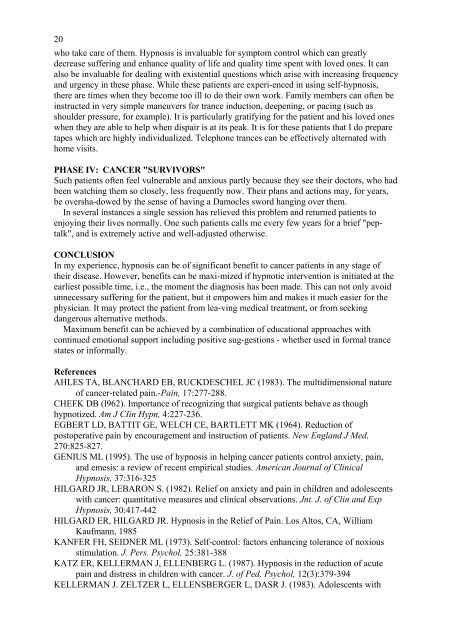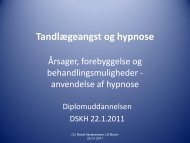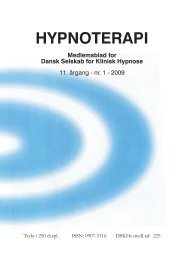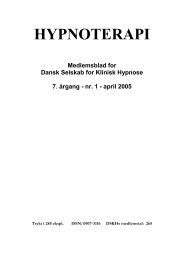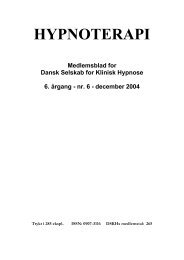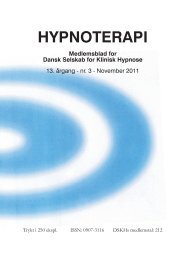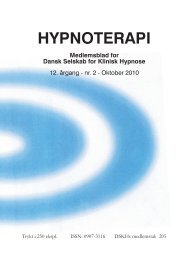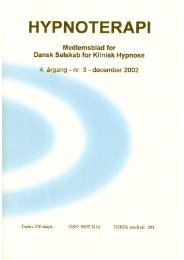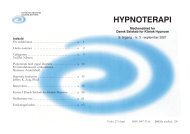HYPNOTERAPl - Dansk Selskab for Klinisk Hypnose
HYPNOTERAPl - Dansk Selskab for Klinisk Hypnose
HYPNOTERAPl - Dansk Selskab for Klinisk Hypnose
You also want an ePaper? Increase the reach of your titles
YUMPU automatically turns print PDFs into web optimized ePapers that Google loves.
20<br />
who take care of them. Hypnosis is invaluable <strong>for</strong> symptom control which can greatly<br />
decrease suffering and enhance quality of life and quality time spent with loved ones. It can<br />
also be invaluable <strong>for</strong> dealing with existential questions which arise with increasing frequency<br />
and urgency in these phase. While these patients are experi-enced in using self-hypnosis,<br />
there are times when they become too ill to do their own work. Family members can often be<br />
instructed in very simple maneuvers <strong>for</strong> trance induction, deepening, or pacing (such as<br />
shoulder pressure, <strong>for</strong> example). It is particularly gratifying <strong>for</strong> the patient and his loved ones<br />
when they are able to help when dispair is at its peak. It is <strong>for</strong> these patients that I do prepare<br />
tapes which are highly individualized. Telephone trances can be effectively alternated with<br />
home visits.<br />
PHASE IV: CANCER "SURVIVORS"<br />
Such patients often feel vulnerable and anxious partly because they see their doctors, who had<br />
been watching them so closely, less frequently now. Their plans and actions may, <strong>for</strong> years,<br />
be oversha-dowed by the sense of having a Damocles sword hanging over them.<br />
In several instances a single session has relieved this problem and returned patients to<br />
enjoying their lives normally. One such patients calls me every few years <strong>for</strong> a brief "peptalk",<br />
and is extremely active and well-adjusted otherwise.<br />
CONCLUSION<br />
In my experiencc, hypnosis can be of significant benefit to cancer patients in any stage of<br />
their disease. However, benefits can be maxi-mized if hypnotic intervention is initiated at the<br />
earliest possible time, i.e., the moment the diagnosis has been made. This can not only avoid<br />
unnecessary suffering <strong>for</strong> the patient, but it empowers him and makes it much easier <strong>for</strong> the<br />
physician. It may protect the patient from lea-ving medical treatment, or from seeking<br />
dangerous alternative methods.<br />
Maximum benefit can be achieved by a combination of educational approaches with<br />
continued emotional support including positive sug-gestions - whether used in <strong>for</strong>mal trance<br />
states or in<strong>for</strong>mally.<br />
References<br />
AHLES TA, BLANCHARD EB, RUCKDESCHEL JC (1983). The multidimensional nature<br />
of cancer-related pain.-Pain, 17:277-288.<br />
CHEFK DB (l962). Importance of recognizing that surgical patients behave as though<br />
hypnotized. Am J CIin Hypn, 4:227-236.<br />
EGBERT LD, BATTIT GE, WELCH CE, BARTLETT MK (1964). Reduction of<br />
postoperative pain by encouragement and instruction of patients. New England J Med,<br />
270:825-827.<br />
GENIUS ML (1995). The use of hypnosis in helping cancer patients control anxiety, pain,<br />
and emesis: a review of recent empirical studies. American Journal of Clinical<br />
Hypnosis, 37:316-325<br />
HILGARD JR, LEBARON S. (1982). Relief on anxiety and pain in children and adolescents<br />
with cancer: quantitative measures and clinical observations. Jnt. J. of Clin and Exp<br />
Hypnosis, 30:417-442<br />
HILGARD ER, HILGARD JR. Hypnosis in the Relief of Pain. Los Altos, CA, William<br />
Kaufmann, 1985<br />
KANFER FH, SEIDNER ML (1973). Self-control: factors enhancing tolerance of noxious<br />
stimulation. J. Pers. Psychol, 25:381-388<br />
KATZ ER, KELLERMAN J, ELLENBERG L. (1987). Hypnosis in the reduction of acute<br />
pain and distress in children with cancer. J. of Ped. Psychol, 12(3):379-394<br />
KELLERMAN J. ZELTZER L, ELLENSBERGER L, DASR J. (1983). Adolescents with


